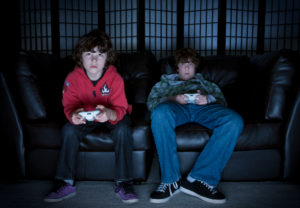This article is part 3 in a 3-part series on punishment.
Not too long ago, my family and I went to the local library together to return our books and to renew our supply. All was well until we got back into the car to go home. Naomi (age 7) got into the backseat before Carter (age 12) and sat in Carter’s favorite spot. This ticked Carter off a bit and he started to get agitated with Naomi. He demanded that Naomi move, and she was more than happy to gloat about getting that coveted location.
Things escalated pretty quickly–as they often can in a family of passionate, emotional people–so Carter decided to use physical force to get his way. This slightly hurt Naomi’s body and really hurt her feelings. Being the protective Dad I am, I said to Carter: “What are you thinking?! It’s a spot in the car for a 5-minute car ride!” Then the lecture began.
About 10 words into the lecture, Carter plugged his ears! That really made my blood boil. I increased the volume of the lecture (not quite yelling yet), and then I caught myself. I got in the driver’s seat and drove home–still upset about Carter’s actions and the perceived disrespect. Little did he know that I was saving the lecture for later when I could get him to listen.
Let’s take a moment to reflect here.
Parents, I’m just going to say it like it is. I did so many more things wrong in this situation than Carter. First of all I’m 25 years older so I am more accountable. I can’t act or react in a way that makes me guilty of a greater offense than he is . . . which is what happened. Second, lectures rarely work in the way we hope — and I mean rarely! Third, the plugging of his ears was not intentional disrespect but a reaction to a useless pastime where I occasionally lecture and he tunes out. If anything, I should see this as a signal that I’m not teaching or connecting. This means it’s time to get off my soapbox, chill out, and think rationally again.
You may still be wondering, “So what did you do?”
I’m glad you asked. Here’s the rest of the story.
When we got home, Carter went straight to his room (I assumed he was upset about my mini lecture). I waited a few minutes–not having calmed down all the way–and knocked on his bedroom door. When the door opened, I started into a different type a lecture and I could tell he looked visibly upset. He stopped me and said: “Dad, I was praying for forgiveness and was about to come ask you and Naomi to forgive me but you interrupted me.” I felt like a piece of garbage.
We’ve tried to teach our children how to remedy a mistake over the years, and here was evidence it was working. It is only through effective teaching and guidance that can help children realize their mistakes and then self-correct. You can’t force remorse–which is what most punishments are attempting to do. Real remorse has to be natural and from within. Being sorry because you were caught and something bad happened to you doesn’t bring about real, heartfelt change.
What Carter needed was connection, not correction. (See the Parenting Pyramid for more details). Any type of punishment in this situation would have gotten in the way of what needed to happen and only made things worse.
We often want the quick fix that punishment provides. Connecting with and effectively teaching our children, on the other hand, require much more time and effort than any punishment demands of us.
Remember the Ping-Pong Parable? It would have been silly for me to punish Eleanor for whacking the table because I’d really be punishing her for having a pathetic teacher (me).
If you were taking tennis lessons and your instructor made you do 20 pushups every time you hit a backhand poorly, you wouldn’t improve your backhand. Instead, you’d just be more fearful when a ball came to your backhand. You’d be even more likely to mess up!
Yet we often do the same thing with children when they can’t control their emotions. And controlling emotions is much more difficult than hitting a backhand! (Trust me, I taught tennis for years.)
We think that some sort of punishment will teach emotional regulation, but instead it impedes it.
So before you use a threat, a lecture, a punitive time-out, a withdrawal of privileges, a grounding, or anything else that might fix the behavior temporarily, consider the following research-based *alternatives:
1. Adjust Your Expectations.
If a problem keeps happening, take the time to analyze the situation with your spouse. Do you need to make any adjustments? Many times parents have created a problem through poor teaching or unrealistic demands, and then the child is the one who gets punished. Take time to reflect on your expectations and be willing to make adjustments as needed. (Make sure you’re keeping the age of your child in mind as well. You shouldn’t expect the same from your 5-year-old that you expect from your 10-year-old.)
Example: Maybe your teen won’t clean his room because of your unreasonable demands. Instead of demanding his room is cleaned exactly to your specifications, find a healthy compromise. Your home will be better off with a slightly messy room and less fighting than it would be with a perfectly clean room.
2. Have Good Reasons and Teach Them.
Don’t have a rule just because you feel like it. Make sure you have good reasons behind what you ask of your children, and make sure your kids understand what those reasons are. (And for the record, “because I said so” isn’t a good reason.)
Example: If your child refuses to wear her seat belt, don’t threaten or bribe. You may have to get out of the car, connect with her, and explain why. Then show her by putting on your own seat belt.
3. Talk Less, Listen More.
Don’t assume you know what the child was thinking, feeling, or deciding. Ask and observe without interrogating! Listen to, acknowledge, and accept feelings. Try to put yourself in their shoes. It’s likely that the misbehavior is merely a symptom of a larger problem. As Stephen Covey teaches, seek to understand before you seek to be understood.
Example: When your child didn’t do his homework, take time to listen. There’s probably more to it than simply willful rebellion. Maybe they’re struggling with the subject or having other difficulties that need to be addressed.
4. Counsel Together.
Find a time when you’re both rational to talk with your children. (This probably won’t be while the conflict is happening.) State your own needs, and ask for their help in finding solutions. Determine rules together. Hold family meetings.
Example: If your teen keeps breaking curfew, decide on a time to come together and talk about the issue. Work together to determine the best solution.
5. Take Your Own Time-out.
Get out of there before you lose it. Explain to the child what you are doing so they know you aren’t just withdrawing love. This is a great example for children to learn how to deal with emotions and have the right kind of time-outs.
Example: When you’re starting to get overwhelmed or frustrated, take time to go for a run, cry, take a shower, or whatever you need to do to cool down.
By the way, bribes don’t work either. It’s just candy-coated control. For more on this see: Can I Bribe Character into My Child? Every disciplining strategy or technique can be measured against the following questions: Is this a “working-with” or “doing-to” approach? Is this more focused on teaching or correction? Am I keeping the long view of character or the short view of behavior in mind?
Learning Process
As evident by my example, we are always learning. Now that you have a few alternatives to punishment, put them into practice! It won’t come all at once, because good parenting is a process. When you start to get discouraged and fall into habits of punishing, remember: there are other options. You can do this!
*Points were largely taken from Unconditional Parenting,Twenty Alternatives to Punishment, and Positive Discipline.






